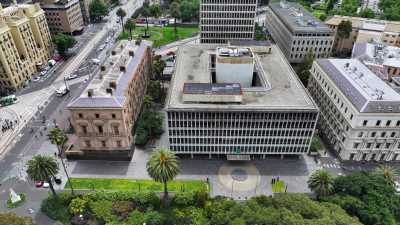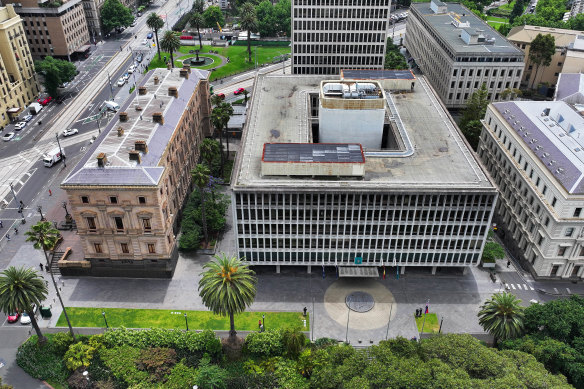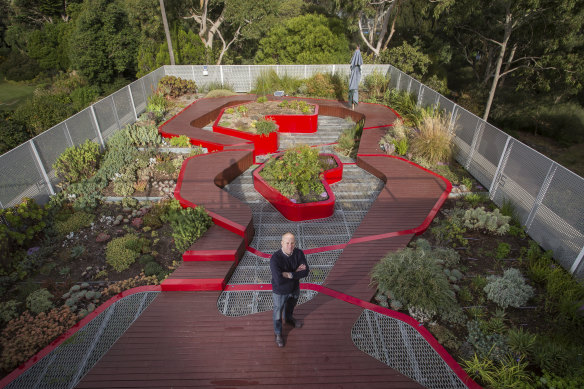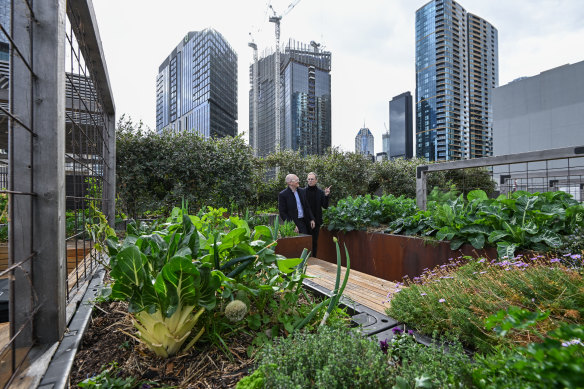
Save articles for later
Add articles to your saved list and come back to them any time.
It was meant to showcase the greening of Melbourne’s skyline by mid-2020.
The modernist office block at 1 Treasury Place was seen as an ideal spot for a green roof demonstration project, with a portion of the urban garden devoted to researching the barriers to green roof construction in Australia.
The concrete roof of 1 Treasury Place was supposed to have been transformed into a green space by 2020.Credit: Joe Armao
But more than three years after the $2.7 million project was due to be completed, the roof remains barren and researchers are unable to access the site.
The stalled project – jointly funded by the state government and Melbourne City Council – highlights the challenges faced by those who want to retrofit green roofs onto existing buildings.
The project “faced unforeseen regulatory barriers resulting in repeated delays and cost increases”, according to a report by academics on a model for a flourishing green roofs, walls and facades sector.
One of the report’s authors, Melbourne University Professor Nicholas Williams, said new fire safety requirements introduced in 2019 meant building the green roof became more difficult than expected.
The state government and council say the Treasury Place green roof was delayed due to unexpected challenges that emerged during the pandemic.
They say construction on the green roof – which was due to be completed in June 2020 – will begin in coming months.
“Once complete, 1 Treasury Place will be one of the first public buildings to have a retrofitted green rooftop in the country,” a government spokesman said. “The Green our Rooftop project will be an example of what can be achieved in green roof design and how it can positively impact our environment.”
Green roofs and walls reduce greenhouse gas emissions, provide cooling, improve air quality and work like a giant sponge by soaking up rainwater, decreasing the risk of flash flooding.
But Australian cities lag behind those in Europe and North America when it comes to greening buildings.
It was hoped the Green Our Roof demonstration project – launched by Climate Change Minister Lily D’Ambrosio in 2019 – would change the slow uptake of green roofs built in Australia.
“We want to lead by example here,” D’Ambrosio said at the time. She said she wanted 1 Treasury Place to act “as a prototype for owners, developers and industry when it comes to establishing a green roof”.
But Williams and other academics – who were funded by not-for-profit horticulture industry group Hort Innovation to research barriers to green roofs, the benefits of the roofs to wellbeing, and plant species and maintenance at 1 Treasury Place – were unable to access the roof.
“The green roof installation at Treasury Place did not go ahead due to unforeseen challenges, including changes to fire regulations, as well as delays due to COVID-19,” a Hort Innovation spokeswoman said.
Eventually, the research was moved to the roof at Melbourne University’s Burnley campus.
Professor Nicholas Williams on a green roof at Melbourne University’s Burnley campus in 2019.Credit: Paul Jeffers
“It can be prohibitively expensive to upgrade a fire safety system into a 1960s heritage building like 1 Treasury Place,” Williams said.
He said a decision was made that the green roof would be inaccessible to the public and researchers due to the regulatory constraints. The research will now be conducted remotely.
Although most of the green roofs built in Melbourne so far are accessible to people, they are considerably more expensive due to additional weight loading, fall safety requirements (such as balustrades) and fire regulations.
Inaccessible green roofs are lower cost but still provide environmental benefits.
“The project has pivoted research to inaccessible green roofs, which is actually pretty valuable because we don’t know how to do that in the Australian context very well,” Williams said.
Visitors inspect SkyFarm in August this year.Credit: Joe Armao
A person involved with the project, who is not authorised to speak publicly, said it was always intended that the green roof at 1 Treasury Place be accessed by the public and used for advancing research.
“What we are left with is a waste of money being spent on a green roof on a building that no one can see or know how well it has performed over time,” they said.
The Green Our Rooftop project at Treasury Place is not alone in being impacted when the National Construction Code was updated in 2019.
SkyFarm, an urban farm on the roof of a Flinders Street carpark, was also affected. It was to include large greenhouses and buildings, but changes to fire safety regulations – including the need for sprinklers on any rooftop structure – put a stop to that.
Director Brendan Condon said there were good reasons for the new regulations introduced following a flammable cladding fire in Docklands and London’s Grenfell Tower inferno.
But these tougher rules and the post-COVID rise in construction costs slowed progress on Skyfarm, which is now up to its fourth redesign. Each redesign hit barriers around technical issues, Condon said, but the latest version has more rooftop farming space and fewer buildings, “because of the expense of putting in fire suppression equipment”.
He said even a steel gantry required expensive sprinklers. “It’s been a case study in the challenges of designing and building a rooftop farm in the city.”
Gail Hall, the president of the Australasian Green Infrastructure Network, said there had been successful green roof retrofits, including SkyFarm and a roof garden on a 1950s apartment block in Westbury Street, St Kilda.
“Even with some successful examples, it is fair to say that it is harder than it should be to retrofit our buildings,” she said.
Hall said challenges included a lack of legislation, which resulted in no mandatory requirements to include green infrastructure in new or retrofitted developments, a lack of government funding and limited guidance and standards.
“With no policy to encourage on-building greening, restrictive requirements to work through, and general unease with what is still seen as novel for some engineers and other regulators, it can be put in the too hard basket.”
The Morning Edition newsletter is our guide to the day’s most important and interesting stories, analysis and insights. Sign up here.
Most Viewed in National
From our partners
Source: Read Full Article


